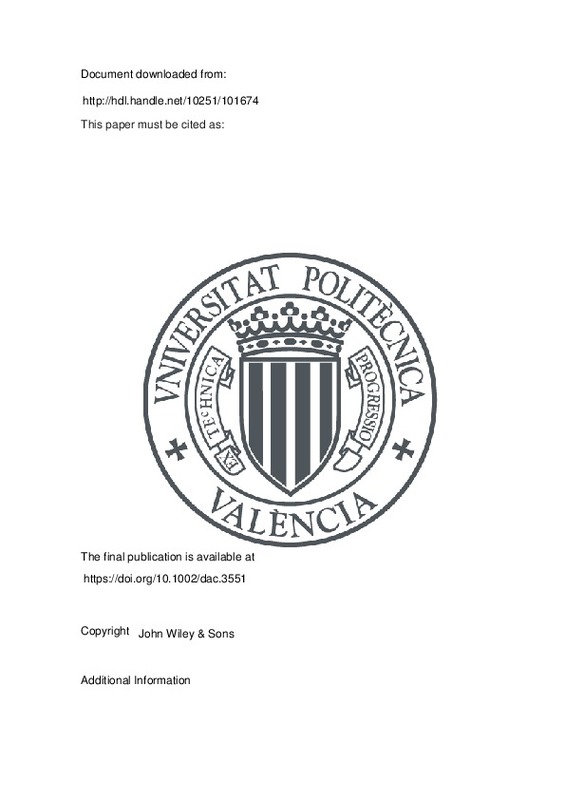JavaScript is disabled for your browser. Some features of this site may not work without it.
Buscar en RiuNet
Listar
Mi cuenta
Estadísticas
Ayuda RiuNet
Admin. UPV
Adaptive Video Streaming Testbed Design for Performance Study and Assessment of QoE
Mostrar el registro sencillo del ítem
Ficheros en el ítem
| dc.contributor.author | Abdullah, Miran Taha Abdullah
|
es_ES |
| dc.contributor.author | Lloret, Jaime
|
es_ES |
| dc.contributor.author | Ali, Aree
|
es_ES |
| dc.contributor.author | García-García, Laura
|
es_ES |
| dc.date.accessioned | 2018-05-10T04:17:51Z | |
| dc.date.available | 2018-05-10T04:17:51Z | |
| dc.date.issued | 2018 | es_ES |
| dc.identifier.issn | 1074-5351 | es_ES |
| dc.identifier.uri | http://hdl.handle.net/10251/101674 | |
| dc.description.abstract | [EN] Hypertext Transfer Protocol adaptive streaming switches between different video qualities, adapting to the network conditions, and avoids stalling streamed frames over high¿oscillation client's throughput improving the users' quality of experience (QoE). Quality of experience has become the most important parameter to lead the service providers to know about the end¿user feedback. Implementing Hypertext Transfer Protocol adaptive streaming applications to find out QoE in real¿life scenarios of vast networks becomes more challenging and complex task regarding to cost, agile, time, and decisions. In this paper, a virtualized network testbed to virtualize various machines to support implementing experiments of adaptive video streaming has been developed. Within the test study, the metrics which demonstrate performance of QoE are investigated, respectively, including initial delay (ie, startup delay at the beginning of playback a video), frequency switches (ie, number of times the quality is changed), accumulative video time (ie, number and length of stalls), CPU usage, and battery energy consumption. Furthermore, the relation between effective parameters of QoS on the aforementioned metrics for different segment length is investigated. Experimental results show that the proposed virtualized system is agile, easy to install and use, and costs less than real testbeds. Moreover, the subjective and objective performance studies of QoE evaluation in the system have proven that the segment lengths of 6 to 8 seconds were faired and more efficient than others according to the investigated parameters. | es_ES |
| dc.description.sponsorship | Ministerio de Economia y Competitividad, Grant/Award Number: TIN2014-57991-C3-1-P | en_EN |
| dc.language | Inglés | es_ES |
| dc.publisher | John Wiley & Sons | es_ES |
| dc.relation.ispartof | International Journal of Communication Systems | es_ES |
| dc.rights | Reserva de todos los derechos | es_ES |
| dc.subject | HTTP adaptive streaming | es_ES |
| dc.subject | Network virtualization | es_ES |
| dc.subject | QoS | es_ES |
| dc.subject | Testbed | es_ES |
| dc.subject | QoE assessment | es_ES |
| dc.subject.classification | INGENIERIA TELEMATICA | es_ES |
| dc.title | Adaptive Video Streaming Testbed Design for Performance Study and Assessment of QoE | es_ES |
| dc.type | Artículo | es_ES |
| dc.identifier.doi | 10.1002/dac.3551 | es_ES |
| dc.relation.projectID | info:eu-repo/grantAgreement/MINECO//TIN2014-57991-C3-1-P/ES/DISTRIBUCION INTELIGENTE DE SERVICIOS MULTIMEDIA UTILIZANDO REDES COGNITIVAS ADAPTATIVAS DEFINIDAS POR SOFTWARE/ | es_ES |
| dc.rights.accessRights | Abierto | es_ES |
| dc.date.embargoEndDate | 2019-01-19 | es_ES |
| dc.contributor.affiliation | Universitat Politècnica de València. Departamento de Comunicaciones - Departament de Comunicacions | es_ES |
| dc.description.bibliographicCitation | Abdullah, MTA.; Lloret, J.; Ali, A.; García-García, L. (2018). Adaptive Video Streaming Testbed Design for Performance Study and Assessment of QoE. International Journal of Communication Systems. 1-15. https://doi.org/10.1002/dac.3551 | es_ES |
| dc.description.accrualMethod | S | es_ES |
| dc.relation.publisherversion | https://doi.org/10.1002/dac.3551 | es_ES |
| dc.description.upvformatpinicio | 1 | es_ES |
| dc.description.upvformatpfin | 15 | es_ES |
| dc.type.version | info:eu-repo/semantics/publishedVersion | es_ES |
| dc.relation.pasarela | S\352956 | es_ES |
| dc.contributor.funder | Ministerio de Economía, Industria y Competitividad | es_ES |







![[Cerrado]](/themes/UPV/images/candado.png)

